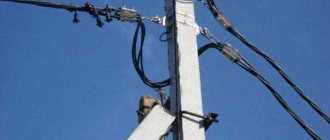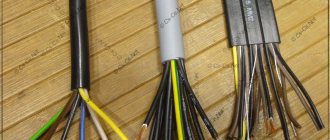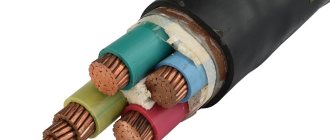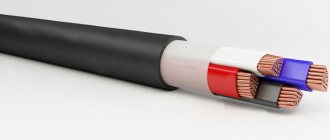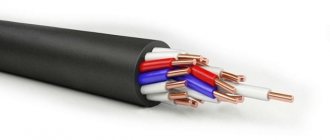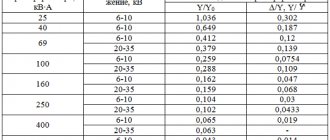Comprehensive supply of cable and wire products and fittings
You probably noticed the presence of letter abbreviations near the cable section markings. It is important to clearly know the meaning of the abbreviation, since the purpose of the cable and other properties depend on it. There you can find such abbreviations as OZH or MN , OK or OS , and for cables with large cross-sections MC . GOST recommends marking cables as soon as the number of cores is indicated, so that the abbreviation indicates the number of cores in the wire.
Thus, the abbreviation OZh means the presence of one core (mono-core), and MN (much less commonly MF) - on the contrary, a multi-core wire device. The abbreviation OK denotes a round conductor with one wire, and MK denotes a round multi-wire conductor. OS is marked as a sector conductor with one wire, and MC as a sector conductor with many wires.
The OZh marking stipulates that the conductor consists of only one conductor that conducts current, and MN - the use of several twisted conductors under one layer of insulation. The multi-core design of wires is most in demand, since they have increased conductivity of electric current, while the heating value of the conductor conductor is low. On the other hand, this design costs much more than single-core cables and wires. In addition, there are certain restrictions on the use of MN (MF) cables in high-frequency power networks.
Another distinctive feature of GOST R 53769-2010 is that the abbreviation may also include the letters (N) or (N,PE) . The letter N indicates the presence of a neutral conductor with blue insulation, and the letters N PE indicate the presence of a ground conductor with yellow-green insulation.
Any of the above letter abbreviations may also contain the numbers -0.38 / -0.66 / -1 / -6 / -10 / -20 / -3 , which determine the rated operating voltage for a particular cable and conductor design. When choosing cables and conductors, you need to pay attention to the number of cores, their purpose - sector, single- and multi-wire, the presence of insulation of a certain color and other parameters.
If you need to purchase a particular cable, you must first familiarize yourself with its technical characteristics, study the number of cores in the conductor and their purpose. This will help ensure industrial safety and protect the electrical system from short circuits. The presence of an abbreviation will help you understand for which electrical network a particular cable is suitable and what recommendations should be followed to avoid emergency situations.
Decoding the markings of Russian-made wires and cables
Power cable with PVC (vinyl) and rubber insulation:
- A - (first letter) aluminum core, if absent; copper core by default
- B - (first (in the absence of A) letter) PVC insulation
- B - (second (in the absence of A) letter) PVC sheath
- G - lack of protective cover (“naked”)
- K - armor made of round galvanized steel wires, on top of which a protective layer is applied, if K is at the beginning of the designation, control cable
- KG - flexible cable
- ng - non-flammable
- LS - Low Smoke (low smoke and gas emissions)
- ng-LS - non-flammable, low smoke emission
- LTx - low toxicity of combustion products
- FR - with increased fire resistance (mica-containing tape is usually used as a fire-resistant material)
- FRLS - with reduced smoke emission, with increased fire resistance
- BB - armored cover made of steel tapes
- BN - armored cover made of steel strips, but with a non-flammable protective layer
- PS - insulation or shell made of self-extinguishing, non-flammable polyethylene
- PV - insulation made of vulcanized polyethylene
- C - lead sheath
- Shv - protective layer in the form of an extruded PVC hose (shell)
- Shp - a protective layer in the form of an extruded hose (shell) made of polyethylene
- R - rubber insulation
- NR - rubber insulation and non-flammable rubber sheath
Examples: AVVG, VVG, AVBbShv
Cable with BPI (paper-belt insulation):
- A - (first letter) aluminum core, if absent; copper core by default
- AB - aluminum armor
- SB - (first or second (after A) letter) lead armor
- l - tape armor
- 2l - double tape armor
- G - lack of protective cover (“naked”)
Examples: ASB, AABL, SBG
Control cable:
- A - (first letter) aluminum core, if absent; copper core by default
- B - (first (in the absence of A) letter) PVC insulation
- B - (second (in the absence of A) letter) PVC sheath
- G - lack of protective cover (“naked”)
- P - polyethylene insulation
- Ps - insulation made of self-extinguishing polyethylene
- F - fluoroplastic insulation
- G - lack of protective cover (“naked”)
- KG - flexible cable
- K - (first or second (after A) letter) - control cable (except KG - flexible cable)
- E - screen
Examples: KVVGe, KVVG, KVBbShng-LS
Telephone cable:
- T - telephone cable
- P - polyethylene insulation
- n - waist insulation; polyamide, polyethylene, polyvinyl chloride or polyethylene terephthalate tapes
- E - screen
- P - polyethylene shell
- Z - hydrophobic filler
- Shp - outer cover made of polyethylene hose
- C - station cable
Examples: TPpp, TPPPePZ, TSVng
Mounting wires:
- M - at the beginning of the designation; installation wire
- G - stranded core, if the letter is missing, then single-wire
- Ш - polyamide silk insulation
- B - polyvinyl chloride insulation
- K - nylon insulation
- L - varnished
- C - fiberglass winding and braiding
- D - double braid
- O - polyamide silk braid
Examples: MGShV, MKSh, MGTFE
Hanging wires:
- A - Aluminum bare wire
- AC - Aluminum-Steel (steel-aluminum) bare wire
- SIP - Self-supporting Insulated Wire
Examples: , SIP
Special designations:
- KSPV - Cables for Data Transmission Systems in PVC sheath
- KPSVV - Fire Alarm Cables with PVC insulation, in PVC sheath
- KPSVEV - Fire Alarm Cables with PVC insulation, with Screen, in PVC sheath
- PNSV - Heating wire, Steel core, PVC sheath
- PV-1, PV-3 - PVC-insulated wire; 1 and 3 are the most applicable core flexibility classes
- PVC - Wire in PVC sheath Connection
- SHVVP - Cord with PVC insulation, in PVC sheath, Flat
- PUNP – Universal Flat Wire
- PUGNP – Universal Flat Flexible Wire
Examples: KSPV, KPSVEV, PVS, ShVVP
Designations in the cable brand, core design characteristics:
- ozh - single-wire conductors (can be either round - OK or sector - OS)
- mn - multi-wire conductors (can be either round or sectored)
- mzh - multi-wire conductors (can be either round or sectored)
- ok - single-wire round conductors
- mk - multi-wire round
- os - single-wire sector
- ms - multi-wire sector
- (N) - zero core, neutral, blue insulation
- (PE) - grounding conductor, yellow-green insulation
Designations in the cable grade in accordance with the requirements of fire codes and regulations:
- ng - cable products that do not spread fire when laid in groups
- ng-LS - cable products that are flame retardant when laid in groups, with reduced smoke and gas emissions
- ng-HF - cable products that do not propagate fire when laid in groups and do not emit corrosive gaseous products during combustion and smoldering
- ng-FRLS - fire-resistant cable products, flame retardant when laid in groups, with reduced smoke and gas emissions
- ng-FRHF - fire-resistant cable products that do not propagate flames when laid in groups and do not emit corrosive gaseous products during combustion and smoldering
- ng-LSLTx - cable products that are flame retardant when laid in groups, with reduced smoke and gas emissions and low toxicity of combustion products
- ng-HFLTx - cable products that do not propagate fire when laid in groups, do not emit corrosive gaseous products during combustion and smoldering, with low toxicity of combustion products
Marking of optical cables. Current world situation
Almost all the largest manufacturers in the world use their own unique names and names for different types of cables, that is, the situation is generally similar to the current situation in Russia.
For example, Corning calls its self-supporting cables SOLO, Prysmian calls it [email protected] , and OFS calls it PowerGuide DT.
Full marking is no exception: each plant has developed its own coding, often very difficult to understand (Fig. 3):
Rice. 3. Examples of marking of foreign manufacturers
It is worth noting that attempts have been made to create a unified labeling. In particular, in the countries of Central Europe, the DIN VDE 0888 standard is widely known, which, among other things, describes uniform principles for coding optical cables by type of design, as well as the materials and optical fibers used. However, this system also has a number of disadvantages, namely:
- The marking does not perfectly describe the design, leaving “blank spots” in the description. For example, it is not clear what type, size and material dielectric elements are used.
- Manufacturers, due to the lack of completeness of options, use their own developments and introduce additional designations. This makes it difficult to unambiguously identify the cable in the future and requires additional search for information and subsequent decoding of the symbols.
As a result of all this, along with the use of DIN VDE markings, manufacturers continue to use their own designations as an alternative.
Thus, we can conclude that neither in the world nor in Russia there is a unified approach and a unified developed system for marking fiber optic cables. This situation remained until recently.
Table of correspondence between brands of main types of optical communication cables
| Old stamps OK (TU 16.K87-001-00) | New OK brands (TU 3587-006-51172458-2010) |
| OMZKGM | OKGM |
| OMZKGC | OKGTS |
| OKSTM | OKKM |
| OKSTC | OKCC |
| OKKTM | OKTM |
| OKKTC | OKTC |
| OKSNM | OKSM |
| OKSNM (with glass fibers) | OKSMs |
| OKPD | OKSD |
| OKPM | OKPM |
| OKPTS | OKPTS |
GOST R for optical cables
The first attempt to create a unified marking system was made in 2004 during the development and implementation of GOST R 52266-2004 “ Cable products. Optical cables. General technical conditions". GOST contained section 4 “Classification”, where in subsections 4.1 - scope of application and 4.2 - symbol, the principles of mark formation were formulated. In fact, the system used did not meet the variety of designs on the market, modern requirements and progress in a rapidly developing industry. As a result, the symbols from this standard were not used by any of the large cable factories.
In 2022, the Electrocable Association and the All-Russian Research Institute of the Cable Industry (VNIIKP) developed a new version of this GOST, which came into force in 2020: GOST R 52266-2020 “ Optical cables. General technical conditions". The section with classification and symbols remained, but was significantly revised. Despite the fact that the division of optical cables remained according to the area of application and laying conditions, the marking system itself, which went through several iterations and approvals, was changed and supplemented. The initial versions of the symbols were very cumbersome: OKZSDHL or OKRDTL and contained, in addition to application characteristics, various other parameters, for example, the type of climate control. All this could lead to the fact that manufacturers would have to certify not tens, but hundreds of different brands. After fruitful discussions, it was possible to make the labeling a little easier and simpler (Fig. 4).
Rice. 4. Symbol of optical cables according to GOST 52266-2020
However, even the newly approved symbols did not relieve the industry of some problems:
- Cable types are still classified by application. This classification does not fully reflect the design features of the cable. The existing design markings of some cable factories describe the composition of the product with the required accuracy. For example, DPS is a central dielectric (D) power element, P is with an intermediate shell and steel wires as armor (C). The consumer clearly understands that he is receiving exactly this cable design. At the same time, the marking according to the conditions of use of other cable factories also clearly defines the materials used, for example, for a cable in a cable duct this is the use of corrugated steel tape. The new GOST does not impose such restrictions. Formally, a cable for laying in a cable duct may or may not contain an intermediate sheath, being of the same brand.
- Cables of a single design can be used in different areas of application. For example, a cable with distributed power elements in the form of glass fibers can be simultaneously used both for laying in protective plastic pipes (OKZTS), and for laying in cable ducts (OKZS), and even as a self-supporting dielectric (OKVDS). The design is the same, but the possible brands are different. An important note has been added to GOST: “The use of OK of one classification subgroup or group instead of OK of other subgroups (for other installation conditions) is permitted provided that all technical characteristics are not worse than those established by this standard for these subgroups.” It turns out that technically the OKVDS cable, with the appropriate technical characteristics, can be laid in the cable duct. However, this creates additional confusion for designers. Therefore, projects will most likely have different names for different installation conditions: OKZS and OKVDS, and at the stage of competitive procedures, manufacturers will explain that the cable uses the same design and can be interchangeable according to the note in GOST. There will be conflicts regarding compliance with the brands specified in the design documentation and unnecessary bureaucratic procedures. This is just one of the particular examples, the number of which is quite significant upon detailed analysis.
- The traditional names of overhead cables used at power generation facilities have been violated. Thus, the OKGT cable (built into the lightning protection cable), according to the new GOST, is called OKVG, and the OKSN cable (self-supporting dielectric) in the new GOST is marked as OKVDA, which will also cause additional inconvenience.
Let's consider the expected benefits of unifying fiber optic cable markings, which are declared by the new GOST:
- The design documentation uses single unified cable brands without reference to a specific manufacturer.
- In procurement documentation for competitions, according to project documentation, uniform markings are also used.
Thus, the same conditions are assumed for all manufacturing plants, without preferences associated with the use of unique brands and difficulties with re-coordination of one brand to another. The opportunity to participate in competitive procedures “on an equal footing” increases competition in the market, which, ideally, should benefit the consumer.
However, a number of disadvantages associated with this become obvious:
- Self-supporting cables from different manufacturers have different characteristics in terms of weight, diameter and elastic modulus. This is due to the high variability of possible designs that meet the same requirements for resistance to mechanical stress. Different characteristics make it impossible to use universal calculations for cable suspension, such as sag and emerging loads. You cannot use data from one manufacturer for calculations, but use a cable from another manufacturer in the project. The project must be recalculated, which negates the benefits of uniform marking. In addition, it is especially dangerous to use a single marking for different external diameters of the designed and purchased cable, since this involves the need to use different tension and support clamps, which may already have been purchased by that time.
- Constant progress in the industry leads to the fact that cables can contain various additional solutions, including innovative ones that are not displayed in the labeling, but bring some added value to the consumer. The simplest example is the presence of ripcord, which makes cable cutting easier and faster for installation crews. If competing manufacturers have only one label, and the consumer chooses according to the label, then it becomes pointless to use this element, since this also increases the cost of production. Thus, uniform labeling hinders technical progress and design development.
- The requirements for new cable classes are not taken into account. For example, the use of Ribbon fibers in cables without armor for installation in cable ducts is impossible according to the new GOST, since there are certain requirements for crush resistance, which this class of cables cannot satisfy despite the promising nature of the design. As a result, the consumer is forced to either refuse to use such cables, or compromise and deviate from GOST requirements.
- Purchasing under a single label will lead to proposals from manufacturers that minimally meet the requirements of GOST. It makes no sense for a manufacturer to add features that potentially affect speed and ease of installation or durability if the consumer is not willing to pay for it. For example, completely “dry” cables, which are gaining popularity in the world. In the worst situation, everyone will start buying “letters and numbers” in markings, without taking into account the design features and potential benefits during installation and operation, which will also directly affect the reliability of lines due to an increase in the number of errors.
The consequence of the emerging shortcomings will be that the market will be divided into two classes of consumers:
- “High-level” customers will have their own additional requirements or special labeling, ensuring the level of quality and ease of use of the products they require. In fact, for this class of Customers, compliance of the optical cable with GOST will not play any role.
- Typical customers will receive standard cables with the minimum possible characteristics according to GOST, without the use of new materials or design developments that provide additional advantages. Thus, for this segment, the real quality level of optical cables will decrease with the introduction of GOST.
Standardization of foreign fiber-optic cable products
Global practice, determined by developed countries, boils down to the fact that a balance between the interests of the customer and the manufacturer must be maintained. The customer always determines his own product requirements, which are not limited to generally accepted international standards such as IEC or IEEE. At least two manufacturers are allowed to participate in the competitive procedure, most often three or four manufacturers. The documentation lists the own markings of approved manufacturers, as analogues of each other. Products from all approved manufacturers must first undergo all necessary inspections and testing, including in independent testing centers. Other manufacturers are not allowed to participate in the competition. Thus, the customer is completely confident in the quality of the products offered and their compliance with their requirements, eliminating incomprehensible manufacturers offering seemingly the same thing, but at the same time providing a competitive offer.
Marking of optical cables. Current situation in Russia
Today, there are more than 20 manufacturers of optical cables in Russia, and the products of each of them have their own unique markings. For example, a classic dielectric self-supporting optical cable (OKSN) in the labeling of the Inkab plant is designated as DPT, in the marking of Saranskkabel-Optics it is designated as OKK, and in the marking of Moskabel-Fujikura - OKSD.
At the same time, the industry has developed two different approaches to the coding of cable types:
- According to the area of application and installation conditions. For example, OKGM, where the letter “G” indicates that the cable is intended for laying in the ground.
- By design. For example, OKL, where the letter “L” means that the cable is armored with steel laminated corrugated tape.
Full marking of a fiber optic cable necessarily contains code designations for design features, as well as the number of optical fibers. Examples of the labeling structure of various manufacturing plants are shown in Fig. 1:
Rice. 1. Examples of the OK marking structure of various plants.
The undoubted disadvantages of the current situation with the marking of optical cables are:
- Difficult and inconvenient to use. To order, the consumer must understand the structure of the fiber optic cable markings and know all the nuances. If products from several manufacturers are purchased, then the complexity increases many times over.
- Difficulty of comparison. Due to the rather strong differences in mark formation systems, direct comparison of markings from different manufacturers is impossible and complete manual decoding and subsequent detailed analysis are required, which is associated with significant labor costs.
- Possibility of errors and typos. It is easy to get confused in the markings, miss the necessary symbols or confuse them. This leads to the fact that, often, even the optical cable manufacturer cannot clearly identify the consumer’s request and is forced to ask clarifying questions, which also lead to wasted time for communication.
Almost all of these shortcomings are mitigated by the presence of the “Marking Translator” configurator on the FOCL.Expert website. After entering the first letters of the marking (cable type), the configurator determines the manufacturer and opens new fields that correspond to the marking system of this plant (Fig. 2).
Rice. 2. General view of the “Marking translator” configurator
Next, the user can fill in the appropriate fields that have a description to facilitate input and eliminate possible errors, and receives a complete description of the cable with detailed characteristics, as well as markings of a similar cable produced by Incab. The whole process requires a small amount of entered data, a couple of mouse clicks and takes literally a couple of minutes. And most importantly, it saves the consumer from the need to laboriously search for a labeling system on manufacturers’ websites, study it and then decipher it.
Go to the “Marking translator” configurator
Optical fiber color coding
The world has not adopted a single standard on what colors and in what order should be used to encode optical fibers in a cable. However, many countries have their own standard: ANSI/TIA-598 in the USA and many other countries, DIN-VDE 0888 in Germany and parts of Europe and others (Fig. 5):
Rice. 5. Examples of color coding of optical fibers in different countries.
12-color coding is generally accepted due to the fact that in low-light conditions, as often happens somewhere in attics or in the field, the human eye can clearly distinguish only 12 colors. And additional colors are seen as shades of the primary ones and can be easily confused. However, more than 12 fibers, up to 96, can be placed in one optical module (tube). In this case, different encoding schemes are possible. The most popular method is to apply additional strokes (ring marks) to the fiber, which can be used for modules containing up to 48 fibers. The first dozen fibers have a standard color coding, and the subsequent ones are marked with one stroke (ring), two or three next to each other. The second possible way is to use colored winding threads that combine dozens. Thus, the winding thread is also a coding element that determines the order of the dozen. When encoding a large number of fibers with streaks or winding threads, there is a nuance that must be taken into account, especially for ultra-low attenuation fibers: additional microbending losses occur, which slightly increase the attenuation. If the optical module uses no more than 16 fibers, then modern standards allow the use of additional colors instead of applying ring marks.
In Russia there is no single standard defining the order of colors of optical fibers. Different factories use different procedures. This leads to great problems and confusion when installing cables from different manufacturers. All consumers note the inconvenience associated with this. It is necessary to redo the schemes for connecting fibers to each other, to take into account and coordinate different colors with each other.
It would seem that the introduction of the new GOST should solve this problem. GOST contains Appendix B, which defines the order of fiber colors in optical modules according to the ANSI/TIA-598 standard. However, this appendix is for reference only and is therefore optional. Accordingly, confusion and inconvenience associated with different colors will continue. For example, the project uses an ANSI/TIA-598 scheme, but the competition will be won by the manufacturer who uses the DIN VDE 0888 encoding, and this will mean an additional headache for the contractor during installation. Or the use of hard-to-distinguish colors will also lead to difficulties and errors in optical fiber splicing.
